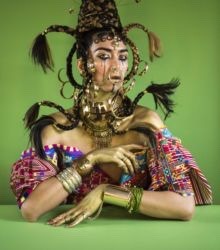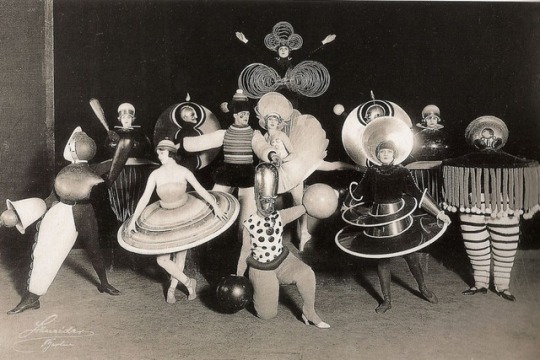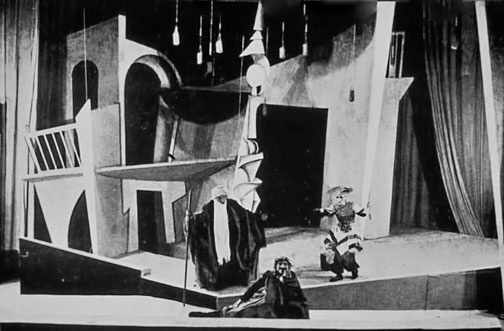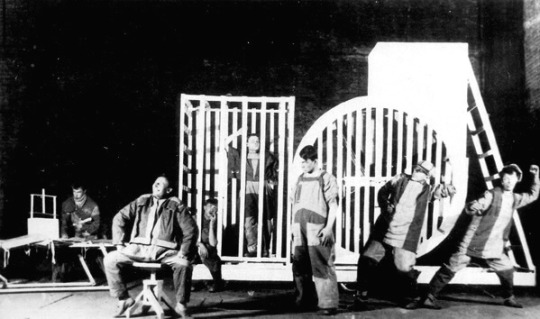WED 4 - 10 PM PROF: POONEH MAGHAZEHE TA: ANAIS PEREZ +++ ALL PROJECT DESCRIPTIONS CAN BE FOUND HERE +++ EMAIL : [email protected]
Don't wanna be here? Send us removal request.
Text



Martine Gutierrez’s in her show “Indigenous Woman.” at Ryan Lee
0 notes
Text






The Bauhaus was the most influential modernist art school of the 20th century, one whose approach to teaching, and understanding art's relationship to society and technology, had a major impact both in Europe and the United States long after it closed. It was shaped by the 19th and early-20th centuries trends such as Arts and Crafts movement, which had sought to level the distinction between fine and applied arts, and to reunite creativity and manufacturing. This is reflected in the romantic medievalism of the school's early years, in which it pictured itself as a kind of medieval crafts guild. But in the mid 1920s the medievalism gave way to a stress on uniting art and industrial design, and it was this which ultimately proved to be its most original and important achievement. The school is also renowned for its faculty, which included artists Wassily Kandinsky, Josef Albers, László Moholy-Nagy, Paul Klee and Johannes Itten, architects Walter Gropius and Ludwig Mies van der Rohe, and designer Marcel Breuer.
0 notes
Text




Constructivism was an artistic and architectural philosophy that originated in Russia beginning in 1913 by Vladimir Tatlin. This was a rejection of the idea of autonomous art. He wanted 'to construct' art. The movement was in favour of art as a practice for social purposes. Constructivism had a great effect on modern art movements of the 20th century, influencing major trends such as the Bauhaus and De Stijl movements. Its influence was widespread, with major effects upon architecture, sculpture, graphic design, industrial design, theatre, film, dance, fashion and to some extent music.
0 notes
Text
Narcisster - Artist Statement
Narcissister employs a spectacle-rich approach to explorations of gender, racial identity, and sexuality. Humor, pop songs, elaborate costumes, contemporary dance, and her trademark mask are her tools in deconstructing stereotypical representations. By opening up and turning against themselves what Stuart Hall calls "fixed and closed stereotypical representations,” Narcissister exposes, in live performance, video and photography, the practice of representation itself, and challenges the audience to question its own attraction and repulsion.
Narcissister questions fetishism, particularly sexual fetishism, which is notorious in its fixing of racist and gendering stereotypes. Rather than abandon this contaminated site, Narcissister dives headlong into the muck, into the depths of the fantasy and fetish itself, to expose and deconstruct their power. Intervening in the exchange between the image and its psychic meaning uncovers the collective fantasies with which we invest these images, and forces representation open.
Narcissister performances, videos, and images, with their unabashed eroticism, therefore question, rather than merely provide, titillation. In addition, humor (Narcissister’s key subversive tool) and deliberately shocking gestures and imagery resist the easy thrill of unexamined sexuality and self-display.
Both Narcissister’s name and her mask reflect the double dynamic created with the work. The Narcissister mask is a repurposed wig display form designed in Los Angeles in 1965 by female entrepreneur Verna Doran. Falling within the narrow conception of femininity and beauty still predominant in the culture, the mask draws in the viewer; simultaneously, the mask – a tool for acquiring and establishing superiority and separation – pushes the viewer away. Similarly, the name Narcissister, while evoking the dysfunction of narcissism, also connotes – through humorous punning – both sisterhood and concerns beyond the self. Self-absorption thus gives way to self-scrutiny through the expansive collection of both culturally significant and culturally debased characters she portrays.
Always staying true to her essential self (a self embodied by the mask), Narcissister enacts the shifting and changing of roles and identities skillfully and gracefully, a nod to the need to accept and surrender to impermanence in the Buddhist sense. Wearing the mask, and portraying a variety of roles, Narcissister is an example of a visceral and kinesthetic experience of seeing the world through another's eyes, of seeing another point of view, and thereby allowing for a broader transpersonal experience.
- Narcissister 2014
0 notes
Video
vimeo
Mary Reid Kelley and Patrick Kelley: The Humours
0 notes

























































